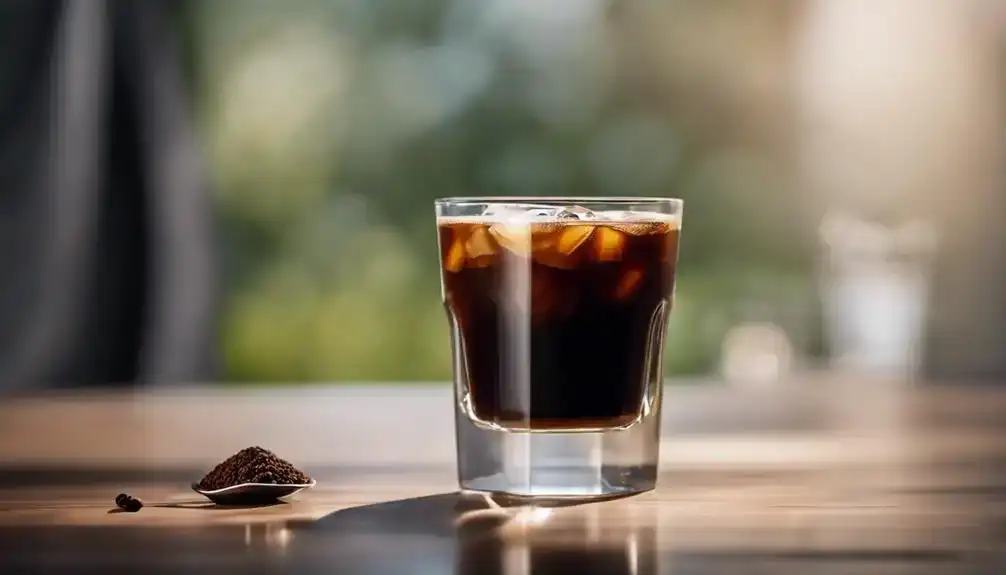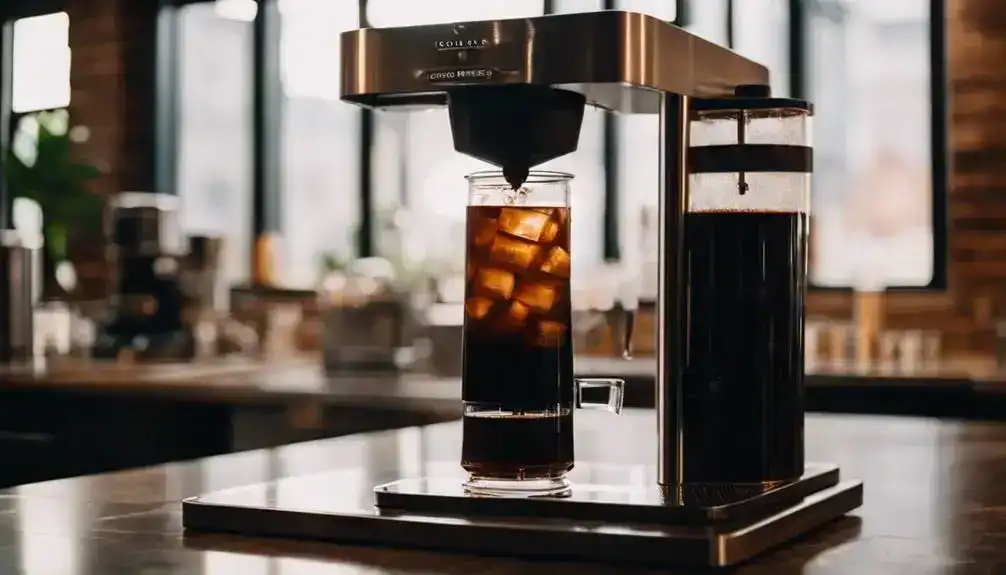You may not realize that despite both being coffee, cold brew and espresso undergo vastly different brewing processes that result in distinct characteristics.
Cold brew coffee and espresso each have unique flavor profiles, caffeine levels, and serving styles that cater to different preferences and occasions.
As you explore the nuances between these two popular coffee options, you’ll uncover surprising differences that might just change how you perceive your daily cup of joe.
Our expert barista with over a decade of experience in the coffee industry provides insights into the intricate details that set cold brew and espresso apart.
The Brewing Process: Cold Brew vs. Espresso
When making cold brew, you prioritize time over temperature, allowing the grounds to steep slowly for an extended period. In contrast, espresso brewing relies on pressure and precise timing to extract flavors quickly.
Understanding these key differences in technique is crucial in appreciating the distinct characteristics of cold brew versus espresso.
Cold Brew Technique: Time over Temperature
Have you ever wondered why time plays a more critical role than temperature in the cold brew technique compared to espresso brewing? When it comes to cold brew, time management takes precedence over temperature control. Here’s why:
- Time Extraction: Cold brew relies on an extended steeping period, typically 12-24 hours, to extract flavors from the coffee grounds slowly.
- Low-Temperature Infusion: The cold brew method uses cold water, which reduces acidity and bitterness, allowing for a smoother extraction over time.
- Flavor Development: By giving the coffee grounds ample time to interact with the water at a cold temperature, unique flavor compounds are extracted, resulting in a distinct taste profile that sets cold brew apart from espresso.
Espresso Technique: pressure and precision
In contrast to the gradual extraction process of cold brew, crafting an espresso relies heavily on pressure and precision to achieve its concentrated and bold flavor profile.
- Pressure Precision: Espresso machines use high pressure (around 9 bars) to force hot water through finely ground coffee, extracting flavors quickly and efficiently.
- Brewing Artistry: Baristas must master the art of tamping the coffee grounds with just the right pressure to ensure even extraction and a balanced taste.
- Timing is Key: Espresso extraction is a delicate dance of timing, where mere seconds can make a significant difference in the final flavor profile of the shot.
Espresso brewing is a dynamic process that marries science with skill, offering coffee enthusiasts a unique and intense experience that celebrates the marriage of pressure precision and brewing artistry.
Cold Brew vs. Espresso Flavor and Aroma

When it comes to flavor and aroma, Cold Brew offers a smooth and subtly sweet profile, while espresso delivers a robust and intense taste.
The slow steeping process of cold brew brings out nuanced flavors, perfect for those who prefer a milder coffee experience.
On the other hand, the concentrated extraction method of espresso results in a bold and full-bodied brew that packs a flavorful punch.
The Smoothness of Cold Brew
For those seeking a smoother coffee experience, the cold brew stands out in contrast to the bold intensity of espresso. Cold brew offers a unique drinking adventure with its silky texture and refreshing chill that invigorates your taste buds. Here’s why cold brew is favored for its smoothness:
- Mellowness: Cold brew’s extended steeping process results in a drink that’s less acidic and smoother on the palate.
- Creamy Elegance: The slow extraction of flavors in cold brew creates a velvety mouthfeel that feels like a luxurious treat.
- Silky Satisfaction: The cold brew’s gentle brewing technique produces a drink that’s rich yet gentle, providing a chilled delight that’s perfect for any time of day.
The Robust Intensity of Espresso
The robust intensity of espresso captivates coffee enthusiasts with its bold flavor and invigorating aroma that sets it apart from the smoothness of cold brew.
When you take a sip of espresso, you’re immediately greeted by a powerful burst of flavor that dances on your taste buds, leaving a lasting impression. The intense aroma that wafts from a freshly brewed shot of espresso can awaken your senses and invigorate your mind, preparing you for whatever the day may bring.
Espresso’s bold flavor is like a symphony of rich, complex notes that linger on your palate, creating a truly immersive coffee experience. Experience the exhilarating intensity of espresso and elevate your coffee journey to new heights.
Cold Brew vs. Espresso Caffeine Content

When comparing Cold Brew and Espresso, it’s essential to consider their caffeine content. Cold Brew offers a gentle surge of caffeine, while Espresso provides a swift boost.
Understanding these differences can help you choose the right pick-me-up based on your caffeine needs and preferences.
Cold Brew’s Caffeine: A Gentle Surge
Comparing the caffeine content between cold brew coffee and espresso reveals a notable difference in the intensity of their caffeine effects on the body. Cold brew coffee, known for its gentle extraction process, offers a caffeine potency that provides a smooth and gradual surge of energy, making it a popular choice for those looking for a milder caffeine boost without the sudden spikes often associated with espresso. Below is a comparison table highlighting the caffeine content differences between cold brew and espresso:
| Coffee Type | Caffeine Content |
|---|---|
| Cold Brew | Higher |
| Espresso | Lower |
This table underscores the fact that cold brew coffee generally contains more caffeine than espresso, contributing to its reputation for a gentle caffeine surge.
Espresso’s Caffeine: A Swift Boost
To understand the contrast between cold brew coffee’s gentle caffeine surge and espresso’s swift boost, consider the differing effects each has on your energy levels. When it comes to espresso, its boldness lies not only in flavor but also in its caffeine content. A single shot of espresso packs a powerful punch, providing you with a quick and intense jolt of energy to kickstart your day. On the other hand, cold brew’s smoothness doesn’t mean it lacks in caffeine; it’s just a more gradual release. The caffeine in cold brew is milder, offering a sustained energy lift without the sudden spike. Choose espresso for a rapid energizing experience or opt for cold brew if you prefer a more measured approach to caffeine consumption.
| Espresso | Cold Brew |
|---|---|
| Bold flavor and high caffeine concentration | Smooth taste and moderate caffeine content |
| Swift energy boost | Gradual and sustained energy release |
Cold Brew vs. Espresso: Acidity and Digestibility

When it comes to acidity and digestibility, cold brew coffee tends to be gentler on your stomach due to its lower acidity levels, making it a great choice for those with sensitive stomachs.
On the other hand, Espresso’s higher acidity gives it a more vibrant and punchy flavor profile that some coffee enthusiasts enjoy.
Consider your preference for acidity and how easily your stomach handles it when choosing between Cold Brew and Espresso for your daily cup of coffee.
Cold Brew’s Lower Acidity Advantage
Opting for cold brew coffee over espresso can offer a lower acidity advantage, which may benefit those with sensitive stomachs. cold brew’s lower acidity benefits are a result of its unique brewing techniques, where coffee grounds are steeped in cold water for an extended period, leading to a smoother, less acidic flavor profile. This makes cold brew a great option for individuals who love coffee but struggle with the acidity found in traditional brewing methods. Additionally, the reduced acidity in cold brew can make it easier on the stomach, providing a gentle and enjoyable coffee experience. Below is a comparison table highlighting the acidity levels of cold brew and espresso:
| Aspect | Cold Brew | Espresso |
|---|---|---|
| Acidity Level | Lower | Higher |
| Flavor Profile | Smooth and Mellow | Bold and Punchy |
| Brewing Method | Cold Water Steeping | High Pressure Extraction |
Espresso’s Acidity: Flavor with a Punch
espresso packs a flavorful punch with its inherent acidity, offering a distinctive taste profile that differs from the smoother notes of cold brew coffee. When it comes to acidity levels, espresso tends to have a higher acidity due to its brewing techniques, resulting in a bright and sharp taste that excites the palate. The shorter extraction time of espresso concentrates the flavors, including its acidity, creating a complex and intense experience. In contrast, cold brew coffee’s brewing process involves steeping coffee grounds in cold water for an extended period, resulting in a mellower and less acidic brew. The table below highlights the key differences in acidity levels between espresso and cold brew coffee:
| Acidity Levels | Espresso | Cold Brew Coffee |
|---|---|---|
| High | Intense | Mellow |
| Brewing Technique | Short extraction time | Long steeping process |
Cold Brew vs. Espresso Serving Styles

When it comes to serving styles, Cold Brew offers versatility in a glass, allowing you to experiment with different flavors and additives.
On the other hand, Espresso embodies tradition in a cup, with its rich and concentrated taste meant to be enjoyed as is.
Each serving style brings its own unique experience, catering to different preferences and occasions.
Enjoying Cold Brew: Versatility in a Glass
Savoring a glass of cold brew offers a refreshing twist on traditional espresso serving styles. Here are three innovative ways to enjoy the versatility of cold brew:
- Cold Brew Cocktails: Elevate your mixology game by incorporating cold brew into cocktails for a unique and sophisticated flavor profile. Try a Cold Brew Martini or a Cold Fashioned for a modern take on classic drinks.
- Cold Brew Desserts: Indulge your sweet tooth with delectable cold brew-infused desserts like tiramisu, ice cream, or even brownies. The rich and smooth taste of cold brew adds depth to your favorite treats.
- Cold Brew Mocktails: For a non-alcoholic option, explore the world of cold brew mocktails. Create refreshing beverages by combining cold brew with fruit juices, soda, or herbs for a revitalizing experience.
Savoring Espresso: Tradition in a Cup
Elevate your coffee experience with the timeless tradition encapsulated in the serving styles of espresso, contrasting the refreshing twist of cold brew. Embracing espresso means diving into a rich world of traditional rituals and coffee heritage, where each sip tells a story of craftsmanship and dedication.
Here’s why you should savor espresso:
- Intense Flavor: Espresso packs a punch of concentrated coffee goodness, amplifying the taste experience.
- Quick Indulgence: Enjoy the swift satisfaction of a shot of espresso, perfect for those on the go.
- Crema Artistry: Witness the beauty of crema, the golden layer atop espresso, showcasing its freshness and quality.
Step into the world of espresso, where every cup is a nod to the past and a celebration of innovation.
Cold Brew vs. Espresso: Preparation and Equipment

When it comes to making Cold Brew, patience pays off as you let the coffee steep slowly in cold water for an extended period.
On the other hand, brewing Espresso requires the machinery of magic, with the intense pressure and heat needed to extract that rich, bold flavor.
The preparation and equipment for these two drinks are as different as night and day.
Making Cold Brew: Patience Pays Off
For optimal results in making cold brew, patience is an essential ingredient that can’t be rushed. To achieve the best cold brew satisfaction, consider the following key steps:
- Coarse Grind: Start by using coarsely ground coffee beans. This grind size is ideal for the slow extraction process of cold brewing, enhancing the flavor profile and reducing bitterness.
- Steep Time: Allow the coffee grounds to steep in cold water for an extended period, typically around 12-24 hours. This prolonged contact time extracts the rich flavors from the beans, resulting in a smooth and mellow cold brew concentrate.
- Strain Carefully: Once steeped, strain the mixture using a fine mesh sieve or cheesecloth to remove the grounds thoroughly. Patience during this step ensures a clean and grit-free cold brew ready for enjoyment.
Brewing Espresso: The Machinery of Magic
To master the art of brewing espresso, understanding the machinery that transforms coffee into a rich and aromatic shot is key. When delving into the world of espresso, here are three key components to consider:
- Espresso Machines: Modern espresso machines offer a variety of features like pre-infusion, pressure profiling, and precise temperature control, allowing you to experiment and perfect your brew.
- Brewing Techniques: From the grind size and tamping pressure to the extraction time, each brewing technique plays a crucial role in achieving that perfect balance of flavors in your espresso.
- Steam Wand: A quality steam wand not only froths milk to velvety perfection for lattes and cappuccinos but also enhances the overall espresso experience with its ability to create latte art.
Cold Brew vs. Espresso: Cultural and Culinary Impact

You’ll explore how Cold Brew has swiftly gained popularity, making its mark in the coffee scene.
Meanwhile, Espresso continues to hold a strong position in the rich tapestry of coffee culture, with its deep-rooted legacy and iconic status.
The contrast between these two beverages highlights the dynamic interplay between tradition and innovation in the world of coffee.
Cold Brew’s Rise in the Coffee Scene
Amidst the bustling coffee scene, cold brew has carved out its own unique space, influencing both cultural preferences and culinary trends.
- Specialty Cafes Embrace Cold Brew Trends:
From small indie shops to big-name brands, specialty cafes are increasingly highlighting cold brew on their menus, catering to the evolving tastes of coffee enthusiasts.
- Innovative Flavor Infusions Elevate Cold Brew:
Creative cold brew innovations like cascara-infused blends or nitrogen-infused varieties are captivating adventurous palates, pushing the boundaries of traditional coffee experiences.
- Cold Brew Inspires New Brewing Techniques:
The rise of cold brew has sparked experimentation with alternative brewing methods, leading to the development of innovative equipment and processes that continue to redefine the coffee landscape.
Espresso’s Enduring Legacy in Coffee Culture
Espresso’s enduring legacy in coffee culture remains a cornerstone of culinary and cultural impact, contrasting with the rising popularity of cold brew.
- Espresso heritage: The rich history of espresso brewing techniques and the art of pulling the perfect shot have shaped coffee culture worldwide.
- Modern evolution: Despite its traditional roots, espresso continues to innovate with new brewing methods and flavor profiles to cater to evolving tastes.
- Global influence: From bustling Italian cafes to specialty coffee shops around the world, espresso’s influence on how we perceive and enjoy coffee is undeniable, transcending borders and cultures.
Espresso’s legacy stands as a testament to the time-honored craft of coffee-making, inspiring a new wave of creativity and appreciation in the ever-evolving world of coffee.
Conclusion
So, next time you’re deciding between cold brew coffee and espresso, consider this: did you know that cold brew coffee has become increasingly popular, with sales growing by 370% from 2015 to 2020?
Whether you prefer the smooth and mellow flavors of cold brew or the bold and intense kick of espresso, both options offer unique characteristics that cater to different preferences and occasions. Choose your brew wisely and enjoy every sip!

